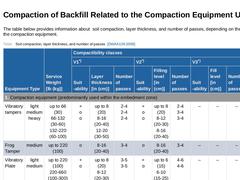
|
The table below provides information about soil compaction, layer thickness, and number of passes, depending on the heaviness of the compaction equipment. (Table: Soil compaction, layer thickness, and number of passes [DWAA139]) (Table: Soil Classification (DWA-A 139)) |
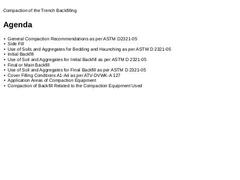
|
|
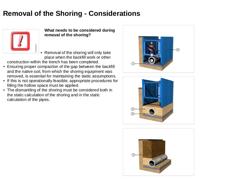
|
(Image: Attention!) What needs to be considered during removal of the shoring? -
Removal of the shoring will only take place when the backfill work or other construction within the trench has been completed.
-
Ensuring proper compaction of the gap between the backfill and the native soil, from which the shoring equipment was removed, is essential for maintaining the static assumptions.
-
If this is not operationally feasible, appropriate procedures for …
|
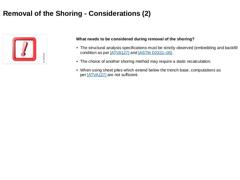
|
What needs to be considered during removal of the shoring? -
The structural analysis specifications must be strictly observed (embedding and backfill condition as per [ATVA127] and [[ASTM D2321–05]].
-
The choice of another shoring method may require a static recalculation.
-
When using sheet piles which extend below the trench base, computations as per [ATVA127] are not sufficient.
|
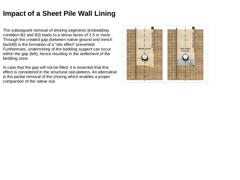
|
The subsequent removal of shoring segments (embedding condition B2 and B3) leads to a stress factor of 2.5 or more. Through the created gap (between native ground and trench backfill) is the formation of a “silo effect" prevented. Furthermore, undermining of the bedding support can occur within the gap (left), hence resulting in the settlement of the bedding zone. In case that the gap will not be filled, it is essential that this effect is considered … |
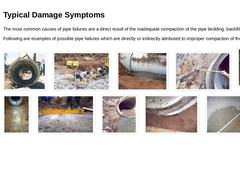
|
The most common causes of pipe failures are a direct result of the inadequate compaction of the pipe bedding, backfill and cover. Following are examples of possible pipe failures which are directly or indirectly attributed to improper compaction of the pipe zone. (Image: Longitudinal failure) (Image: Inappropriate use of a heavy compactor) (Image: Failure to meet the minimum trench width) (Image: Failure to meet the minimum trench width) (Image: Inadequately … |
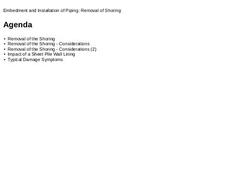
|
|
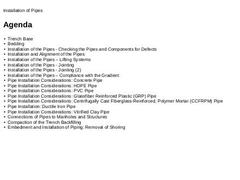
|
|

|
Flowable fill is a self-compacting low strength material with a flowable consistency that is used as an economical fill or backfill material, as an alternative to compacted granular fill. Flowable fill is not concrete nor it is used to replace concrete [[ACI 229R]]. Terminology used by [[ACI 229R]] for this material are unshrinkable fill, controlled density fill, flowable mortar or lean-mix backfill. On the following pages are presented the advantages … |

|
Hydraulically bounded filling materials consist principally of the following raw materials: -
Filler material, such as native aggregates or recycled materials
-
Plasticizer, for example, mixture of water swellable clay (bentonite), foaming agents, air pore-forming additives (surfactants) or other mineral, organic and / or inorganic additives,
-
Stabilizer (binder), such as cement or lime.
The hydraulically bonded fill mixture is composed of about 95% … |
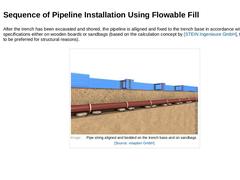
|
After the trench has been excavated and shored, the pipeline is alligned and fixed to the trench base in accordance with the planning specifications either on wooden boards or sandbags (based on the calculation concept by [Prof. Dr.-Ing. Stein & Partner GmbH], the latter are to be preferred for structural reasons). (Image: Pipe string aligned and bedded on the trench base and on sandbags) |
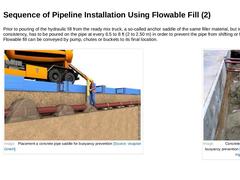
|
Prior to pouring of the hydraulic fill from the ready mix truck, a so-called anchor saddle of the same filler material, but in a firmer consistency, has to be poured on the pipe at every 6.5 to 8 ft (2 to 2.50 m) in order to prevent the pipe from shifting or floating. Flowable fill can be conveyed by pump, chutes or buckets to its final location. |
(Image: Placement a concrete pipe saddle for buoyancy prevention) |
(Image: Concrete pipe saddle for buoyancy … |
|
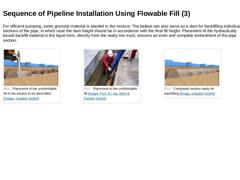
|
For efficient pumping, some granular material is needed in the mixture. The ballast can also serve as a dam for backfilling individual sections of the pipe, in which case the dam height should be in accordance with the final fill height. Placement of the hydraulically bound backfill material in the liquid form, directly from the ready mix truck, ensures an even and complete embedment of the pipe section. (Image: Placement of the unshrinkable fill … |

|
|
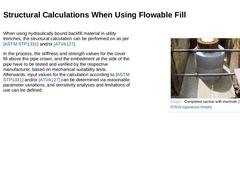
|
When using hydraulically bound backfill material in utility trenches, the structural calculation can be performed on as per [[ASTM STP1331]] and/or [ATVA127]. In the process, the stiffness and strength values for the cover fill above the pipe crown, and the embedment at the side of the pipe have to be tested and verified by the respective manufacturer, based on mechanical suitability tests. Afterwards, input values for the calculation according to [[… |
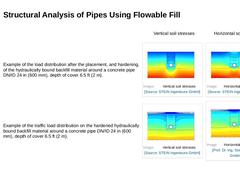
|
|
|
Vertical soil stresses |
Horizontal soil stresses |
|
Example of the load distribution after the placement, and hardening, of the hydraulically bound backfill material around a concrete pipe DN/ID 24 in (600 mm), depth of cover 6.5 ft (2 m). |
(Image: Vertical soil stresses) |
(Image: Horizontal soil stresses) |
|
Example of the traffic load distribution on the hardened hydraulically bound backfill material around a concrete pipe DN/ID 24 in (600 mm), … |
|
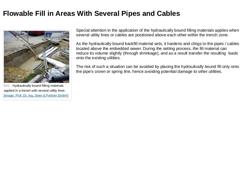
|
(Image: Hydraulically bound filling materials applied in a trench with several utility lines) Special attention in the application of the hydraulically bound filling materials applies when several utility lines or cables are positioned above each other within the trench zone. As the hydraulically bound backfill material sets, it hardens and clings to the pipes / cables located above the embedded sewer. During the setting process, the fill material … |
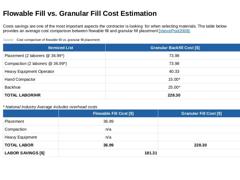
|
Costs savings are one of the most important aspects the contractor is looking for when selecting materials. The table below provides an average cost comparison between flowable fill and granular fill placement [[VancePool2008]]. (Table: Flowable fill vs. granular fill cost) |
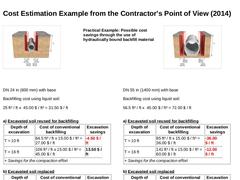
|
(Image: Seitenverfuellung Einsparpotential Fluessigboden DN 350 - DN 700) Practical Example: Possible cost savings through the use of hydraulically bound backfill material (Image: Seitenverfuellung Einsparpotential Fluessigboden >DN 1200) DN 24 in (600 mm) with base Backfilling cost using flowable fill: 25 ft³ / ft x 45.00 $ / ft³ = 31.50 $ / ft a) Excavated soil reused for backfilling |
Depth of excavation |
Cost of conventional backfilling |
Excavation … |
|---|
|

|
Various advantages make the use of hydraulically bound backfill materials a good alternative to the conventional backfilling of utility trenches with granular, unbound back-fill material: -
Prevention of typical installation errors/damage causes that can occur during the conventional installation procedure (e.g. insufficient backfilling and compaction in the spaces either side of the pipe, point loading of the pipe etc.)
-
Reduction of the trench widths …
|
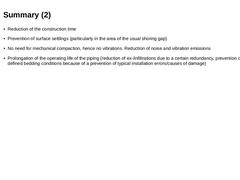
|
-
Reduction of the construction time
-
Prevention of surface settlings (particularly in the area of the usual shoring gap)
-
No need for mechanical compaction, hence no vibrations. Reduction of noise and vibration emissions
-
Prolongation of the operating life of the piping (reduction of ex-/infiltrations due to a certain redundancy, prevention of root ingrow, defined bedding conditions because of a prevention of typical installation errors/causes of …
|

|
It should be noted that (if at all possible) the use in utility trenches with a steep gradient (> 10 %) requires special equipment. In the case of a practical application, expert consulting engineers should be requested to determine the precise requirements for the individual case (general, mechanical/structural, chemical, thermal etc.), as well as to carry out the required analyses for a verification of the serviceability, provided that these have … |
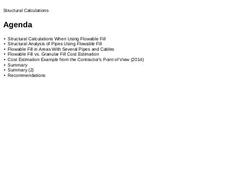
|
|
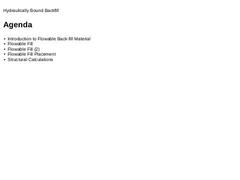
|
|
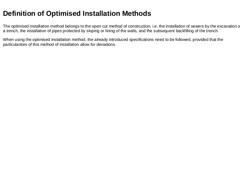
|
The optimised installation method belongs to the open cut method of construction, i.e. the installation of sewers by the excavation of a trench, the installation of pipes protected by sloping or lining of the walls, and the subsequent backfilling of the trench. When using the optimised installation method, the already introduced specifications need to be followed, provided that the particularities of this method of installation allow for deviations. |